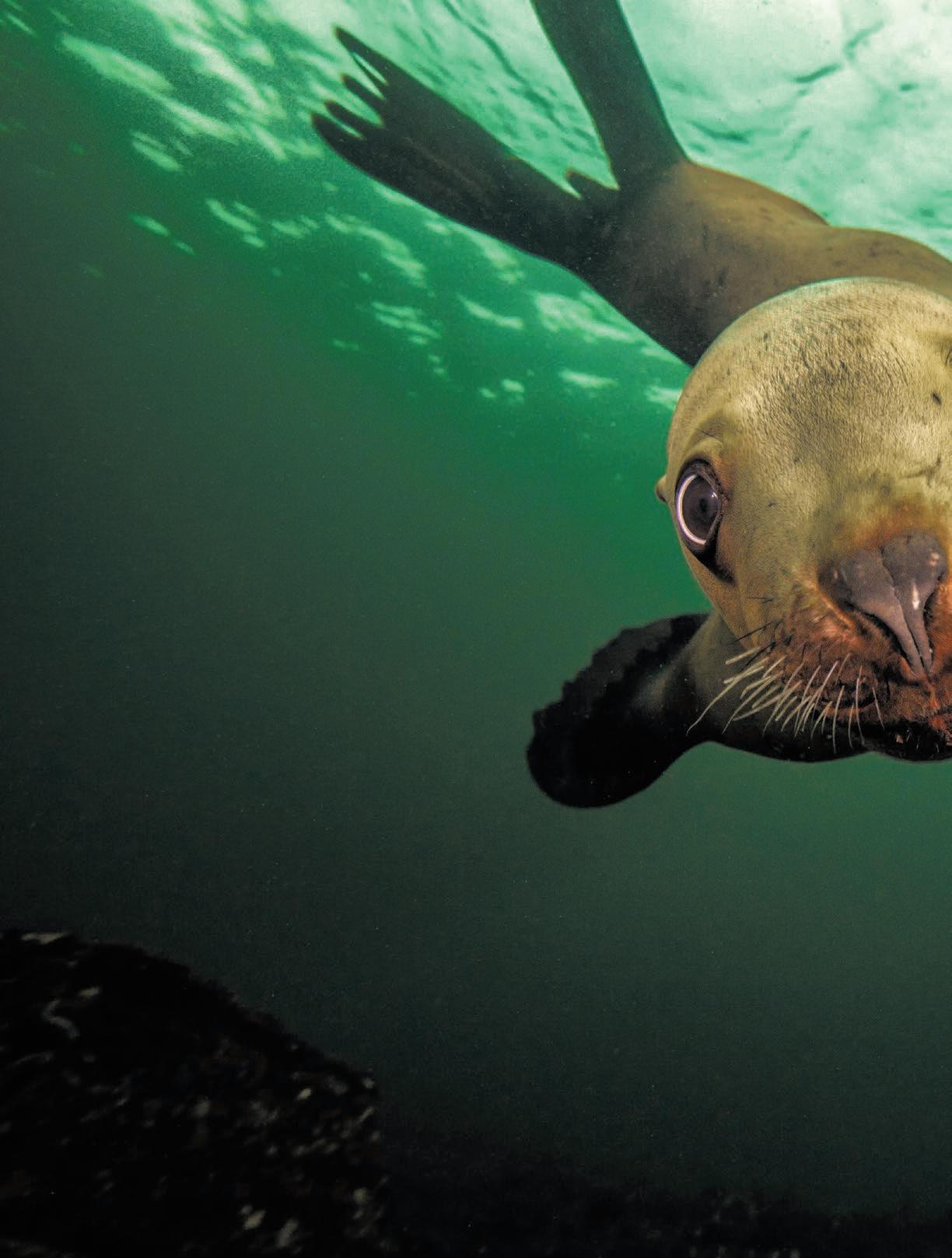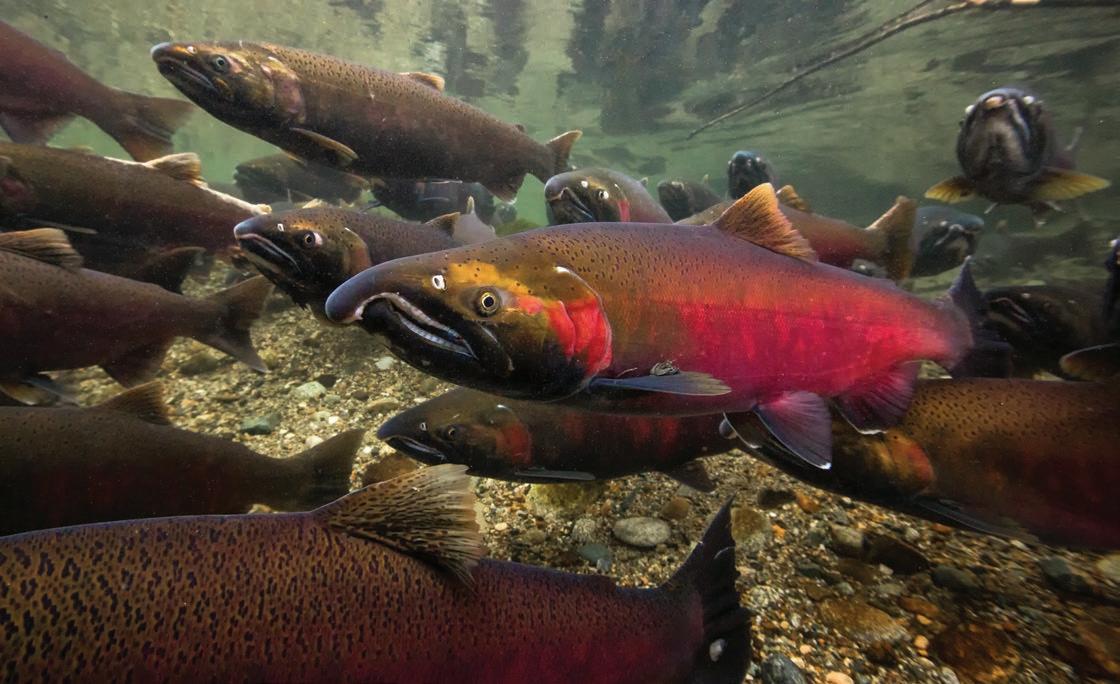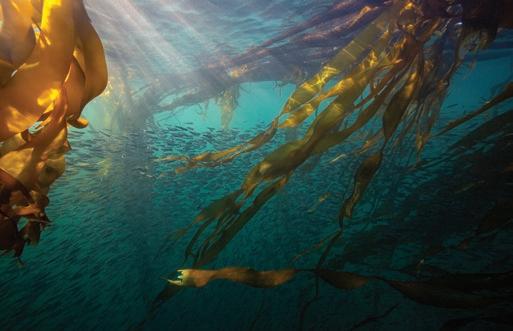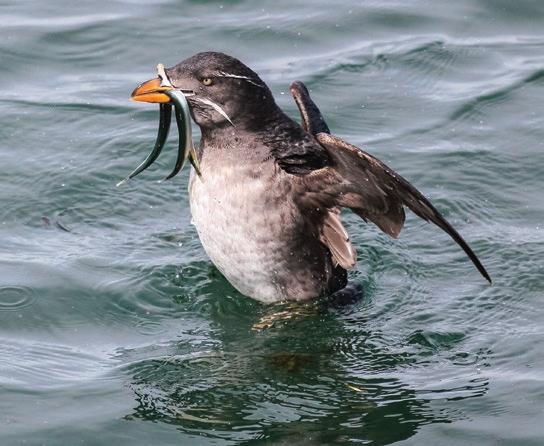
7 minute read
Beneath the Surface
Surface Explore the Wonders below the San Juan Islands
Story by Jess Newley
Breaching killer whales, soaring eagles, and sea lions hauled out on rocks along stunning shorelines—these are just a few of the sights that people travel to the San Juan Islands every year by foot, boat, or plane to behold. Of course, if you’ve been to the islands before, then you know their moniker as “the hidden gem of Washington State ” is true. But did you know that under the water, there is a whole system of wondrous natural resources (eelgrass, kelp, forage fish, juvenile salmon, and of course, killer whales (Orcinus orca), to name a few) that support what we get to experience above the surface?
Residents and visitors alike play an important role in stewarding the marine habitats of the Salish Sea. Read on to learn more about a few vital habitats and species of this region and how you can help support and maintain them.
Eelgrass is a flowing plant that grows in shallow, light-filled marine waters, forming large meadows of underwater vegetation that support aquatic food webs. It is easy to see eelgrass at low tide, especially in the spring and summer when it thrives. However, eelgrass abundance varies seasonally, with some winter die-offs. The long blades of eelgrass are an underwater nursery for incubating eggs, such as herring, and provide food and refuge for a wide array of small creatures and young animals, including Dungeness crab, juvenile flatfish, and salmon. Eelgrass beds are also important feeding areas for birds. In addition, eelgrass mitigates wave energy and traps sediments, safeguarding shorelines from wave-driven erosion.

This adult Coho Salmon will pass through the San Juans twice in its life span- once as a juvenile to find rest and food along shoreline habitat like eelgrass and kelp, and once again as an adult on its way back when the Southern Resident killer whales may feed on them.
Photo by Jess Newley
If you are a boater, you can help protect eelgrass beds by anchoring in water deeper than 30 feet. While each anchor might create just a small scar, the cumulative effects can be dramatic enough to be seen in satellite images from space! To avoid damaging grass, use a public marina or mooring buoy. When those options are unavailable, anchor deeper than 15 feet at low tide in bays and in more than 30 feet of water in more open areas. You can explore an eelgrass depth map at sanjuans. org/greenboating and see for yourself where eelgrass is growing around the islands. Lastly, avoid chemicals when cleaning your boat, and if you live near the shoreline, limit the use of lawn and garden chemicals.
Known as “the rainforest of the sea”, kelp beds are another vital habitat found around the islands. Bull kelp, growing up to a foot a day in subtidal waters, sometimes at depths of over 60 feet, is one of the fastest-growing organisms on earth. Clusters of bull kelp can be seen offshore of almost any high-energy rocky coastline in the San Juans. Also, numerous species of understory kelps grow along rocky bottoms, providing additional habitat complexity to the kelp forest. Kelp provides shelter to sea urchins, otters, seals, crabs, juvenile rockfish and salmon, anemones, starfish, sea cucumbers, octopuses, and many other marine creatures. Kelp needs clean water and light to thrive because, unfortunately, it is very sensitive to pollution from small and large oil spills, soil erosion, and yard chemicals.
If you live near the shoreline and have a septic system, you can help by ensuring your septic system is working correctly and reducing your use of chemicals. If you are a boater, keep your boat in good condition, and clean even minor fuel spills using absorbent pads—not soap! Never soap! And, of course, for your safety and to protect the kelp, always steer clear of kelp beds when underway.
Small schooling forage fish, or bait fish, are essential staples in the diets of fish, seabirds, and marine mammals, including Chinook and coho salmon, lingcod, marbled murrelets, rhinoceros auklets, and minke whales. Primary species in the Salish Sea are pacific herring, pacific sand lance, and surf smelt. Each forage fish plays an essential role in marine food webs by transferring energy from plankton to larger species.
Forage fish do not spawn just anywhere. Pacific herring deposit transparent, adhesive eggs on eelgrass and marine algae close to shore. Surf smelt and pacific sand lance incubate their eggs on beach sand and small gravel near the high tide line. These spawning forage fish utilize the same shoreline areas where humans concentrate activities, making them vulnerable to shoreline alterations such as armoring or bulkheads, docks, roads, and vegetation removal. You can help forage fish by keeping beaches natural with plenty of overhanging native trees and shrubs. Large driftwood is also beneficial as it helps to maintain cool, moist conditions for the tiny eggs.
It’s hard to visit or live in Washington State without hearing about salmon. These fish are the lifeline to indigenous cultures, economic stability, ecosystem functionality, and much more. But did you know that the San Juans are a critical rearing habitat for juvenile salmon? Each spring and summer, young salmon, just inches long, migrate from their natal rivers along the shores of the Salish Sea into the productive shoreline habitats of the islands. Researchers have found that the time juvenile salmon spend nearshore, eating and growing as fast as possible, is critical to their survival as adults.
Marine mammals such as southern resident killer whales depend on adult salmon for food as these anadromous fish pass through the San Juans on their way to spawn in their natal rivers. Salmon are also culturally vital to indigenous tribes in the Pacific Northwest.
To help salmon, avoid single-use plastics that often make their way into rivers and marine waters. If you are a waterfront property owner, there is much you can do to support salmon populations. Did you know that juvenile salmon eat insects that fall into the water from shoreline vegetation? By keeping your beach free of shoreline modifications and retaining overhanging vegetation, detritus, and driftwood, you will support the insects and forage fish that young salmon eat. Also, juvenile salmon tend to avoid swimming under docks and instead move out into the deeper waters, where they are at risk from predators. To reduce demand for new docks, consider using a marina, mooring buoy, or sharing an existing dock with neighbors. If you already have a dock, look into improvements such as grating that can increase light penetration.

A large school of forage fish swims through bull kelp on the west side of San Juan Island. Kelp forests like this not only sequester more carbon than forests on land, they also provide food and shelter for many species in the marine food web, including these Pacific herring.
Photo by Jess Newley
We have two killer whale populations swimming through Salish Sea waters and the San Juan Islands. The most well-known are the southern resident killer whales, an endangered species that used to regularly spend their summers in the region but are visiting the islands less. Southern residents depend primarily on a diet of Chinook salmon, a threatened species that are increasingly harder for the orcas to find. Southern Residents need space and quiet waters to find this limited food.
We also have transient killer whales (a.k.a. Bigg’s killer whales), who are currently thriving in the Salish Sea, where their primary food sources—harbor porpoises, seals, and sea lions—are plentiful.
Luckily there are many places in the San Juans to view these extraordinary species from shore. Consider joining the regional Give Them Space movement to avoid watching the endangered Southern Residents from vessels. Instead, focus on the exciting Bigg’s whales or view the whales from shore at Lime Kiln State Park on San Juan Island. If you end up boating near the Southern Residents, stay at least 400 yards away. Visit BeWhaleWise.org for more information and viewing guidelines.

This Rhinoceros Auklet will fill its mouth with as many fish as it can to bring back to its nest. From birds, to salmon, to killer whales, and humans, we all depend on small forage fish like these and the habitat that sustains them—culturally, economically, and intrinsically! And they depend on us as stewards of this special place.
Photo by Andrew Reding
Salmon, eelgrass, bull kelp, forage fish, and orcas—all of these wondrous things are connected in ways that we don’t always see or experience as humans living above the surface of the Salish Sea. If we lose one of these critical pieces of the puzzle, the Salish Sea and all who rely upon it will suffer. Therefore, it is increasingly vital that we all do our part to take care of this special place and do what we can to protect it for people and nature.
Next time you look out the ferry window, off the aft of a boat, or gaze from a plane as you fly over, take a moment and go deeper. Remember that this amazing and complex web of life outside our usual view depends on all of us to steward and protect it.










